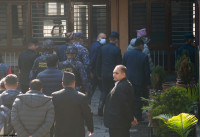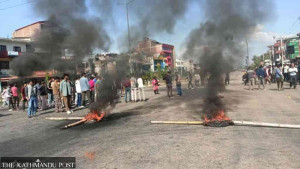National
Inclement weather halts all three winter Everest expeditions
Heavy snowfall for two days on the world’s highest peak has led to the cancellation of all expeditions planned for the winter.
Sangam Prasain
All three winter expeditions planned on Mt Everest have been called off due to threats of avalanches following the accumulation of fresh snow deposits on the world’s highest peak.
Nepal’s winter season officially ends on Saturday and along with it, the climbing permits issued for a winter expedition become invalid.
Expedition organisers said that the mountain received heavy snowfall for two consecutive days—starting February 25—amassing large snow deposits on the higher reaches of the mountain. These deposits risk causing avalanches when they are blown down to the lower reaches by high winds. The snow also obstructs the Khumbu Icefall, among the most treacherous sections on the Everest route, causing difficulties in passing.
The Breathless Winter Everest Speed Climbing team abandoned its winter expedition on Thursday. The team, comprising four Sherpa climbers, had set off to the mountain earlier this week in a bid to make the fastest climb on Everest—reaching the top from Kathmandu in just seven days.
The team led by Tashi Lakpa Sherpa, an eight-time Everest summiteer, had left Kathmandu for Everest Base Camp on Monday. It had planned to reach the summit on Saturday and return to base camp and then Kathmandu on March 1, as per the team’s itinerary.
In normal circumstances, it takes several weeks to climb Everest.
“The team reached Camp III at 7,100m and decided to abandon the expedition due to 34 hours of fresh and soft snowfall on blue ice surfaces that can become slippery and dangerous,” said Seven Summit Treks, the organiser of the expedition, on its Facebook page.
German alpinist Jost Kobusch, who had been camping on the slopes of Everest for the last three months, also abandoned his mission as the winter climbing permit is only valid until February 29, said Rishi Bhandari, managing director of Satori Adventures, which is handling his climb.
“He reached the high point at 7,329 meters,” said Bhandari. “A high wind factor—blowing over 120km per hour—stopped his climb and during the last push, heavy snowfall ended all hope.”
The German climber was exploring a new route on the west ridge, which has never been climbed in winter before, without supplemental oxygen.
“I reached my goal—planned to reach the 7,200m again on this climb and I reached 7360 m. I felt great up there and took some pictures. Could have even continued, the weather seemed to be holding up, but my intuition told me: stop—if you want to tackle the summit you should have stayed at least 7500m-8000m before and have been relegated again,” Kobusch said on his Facebook page on Thursday.
Spanish alpinist Alex Txikon is also returning to Kathmandu on Saturday. Initially, his team, which was making a winter attempt without supplemental oxygen, consisted of two other Spanish climbers Oscar Cardo and Jonatan Garcia Villa, along with three Sherpas. His two colleagues have already abandoned the mission.
Pemba Sherpa, managing director of Outware Treks and Expedition which is handling the Txikon expedition, said that the team reached a highest point of 6,900m and ended there.
“It's over now. We're all fine... by miracle! If we would have continued, we would not have made it back alive. Nearly 1m snow in C1. 50cm on the way to C3. The entire Lhotse face was about to slide down upon us. Feeling lucky to be back,” Txikon tweeted on Friday.
Krzysztof Wielicki of Poland first climbed the world’s tallest peak in the dead of winter on February 17, 1980. The last successful winter ascent, according to Tourism department records, was made by Shinsuke Ezuka of Japan on Dec 20, 1993.
The winter climbing permit lasts until the February-end. The government charges $2,500 per person for climbing Everest using other routes. During the spring and autumn, the other routes cost $10,000 and $5,000 respectively.
Everest normally sees the highest number of climbers during the spring season. Very few have climbed it during the autumn and winter seasons.
In the 1980s, climbing in autumn and winter was more popular than in the spring. After the advent of democracy in 1990 in Nepal, the government adopted a liberal economic policy in 1992 and Everest was also opened up to everyone, during any season. As a result, climbers started to avoid the autumn and winter climbing seasons due to the risk of snow and the extreme cold.




 14.12°C Kathmandu
14.12°C Kathmandu













%20(1).jpg&w=300&height=200)

